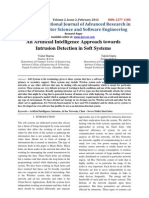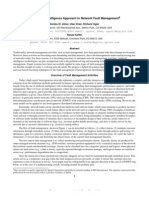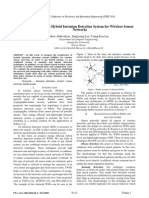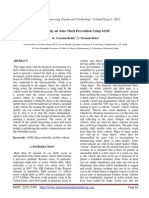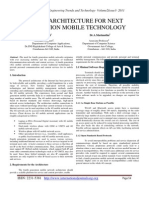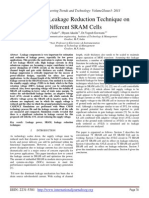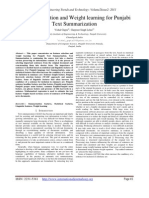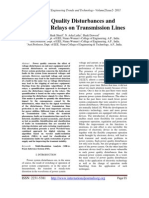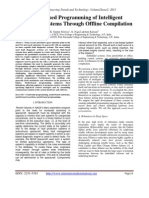Automated Anomaly and Root Cause Detection in Distributed Systems
Automated Anomaly and Root Cause Detection in Distributed Systems
Uploaded by
surendiran123Copyright:
Available Formats
Automated Anomaly and Root Cause Detection in Distributed Systems
Automated Anomaly and Root Cause Detection in Distributed Systems
Uploaded by
surendiran123Original Title
Copyright
Available Formats
Share this document
Did you find this document useful?
Is this content inappropriate?
Copyright:
Available Formats
Automated Anomaly and Root Cause Detection in Distributed Systems
Automated Anomaly and Root Cause Detection in Distributed Systems
Uploaded by
surendiran123Copyright:
Available Formats
International J ournal of Engineering Trends and Technology- Volume3Issue1- 2012
ISSN: 2231-5381 http://www.internationaljournalssrg.org Page 47
Automated Anomaly and Root Cause
Detection in Distributed Systems
G.D.K.Kishore
1
, Maddali Sravanthi
2
, Kurma Siva Naga Mrudhula
3
, J Sandeep
4
, Kilaru Swapna
5
1Asst.Professor, Dept. of Computer Science & Engineering, KLCE-522502,INDIA,
2,3,4,5,Student, Dept. of Computer Science & Engineering, KLCE-522502, INDIA,
Abstract I t is a challenging issue to
identify a defective system in a large scale network.
The data collected from the distributed systems for
troubleshooting is very huge and may contain noisy
data, so manual checking and detecting of the
abnormal node is time consuming and error prone. I n
order to solve this, we need to develop an automated
system that detects the anomaly. Though the defective
node is found it has to be rectified, for this we need to
know the root cause of the problem. I n this paper we
present an automated mechanism for node level
anomaly detection in large-scale systems and the root
cause for anomaly. A set of data mining techniques
are used here to analyze the collected data and to
identify the nodes acting differently from others. We
use I ndependent Component Analysis (I CA) for
feature extraction. We also present some of the
mechanisms needed to know the root cause of the
problem. So the results will be abnormal nodes and
problem to be rectified in them. These can be
validated manually.
Keywordsnode level anomaly identification,
large-scale systems, data mining techniques,
independent component analysis.
1 I NTRODUCTI ON
Large scale distributed systems are becoming key
engines of IT industry. For a large commercial
system, execution anomalies, including erroneous
behavior or unexpected long response times, often
result in user dissatisfaction and loss of revenue.
These anomalies may be caused by hardware
problems, network communication congestion or
software bugs in distributed system components.
Most systems generate and collect logs for
troubleshooting, and developers and administrators
often detect anomalies by manually checking
system printed logs. However, as many large scale
and complex applications are deployed, manually
detecting anomalies becomes very difficult and
inefficient. In the distributed systems every hour
that a system is unavailable can cause undesirable
loss of processing cycles, as well as substantial
maintenance cost. When a system fails to function
properly, health-related data are collected across
the system for troubleshooting. Unfortunately, how
to effectively find anomalies and their causes in the
data has never been as straightforward as one
would expect. Traditionally, human operators are
responsible of examining the data with their
experience and expertise. Such manual processing
is time-consuming, error-prone, and even worse,
not scalable. As the size and complexity of
computer systems continue to grow, so does the
need for automated anomaly identification. To
address the problem, in this paper, we present an
automated mechanism for node-level anomaly
identification and the root cause for the anomaly
behaviour of the node. By finding the abnormal
nodes and the cause for the anomaly, system
managers are able to know where to fix the
problem and what problem to fix. The use of the
node in the error state can lead to node failure.
Hence, we seek to discover the nodes in error or
failed states, which are also called abnormal states
in the paper; we regard these nodes as anomalies
that require further investigation to say what makes
the node anomaly.
2 METHODOLOGY OVERVI EW
This automated mechanism can be triggered either
periodically with a predefined frequency or by a
system monitoring tool in case of unusual events.
In this paper, we focus on detecting anomalies in
homogeneous collection of nodes (also called
groups),and the reason for their anomaly
behaviour . The resulting list of anomalies and the
causes will be sent to system administrators for
final validation. As we will see later, by combining
the fast processing capability of computers with
human expertise, the proposed mechanism can
quickly discover anomalies and the causes with a
very high accuracy. The step we perform for
anomaly detection are
2.1. Data transformation. It is collection of
relevant data across the system and assembling
them into a uniform format called feature matrix
(generally in high dimensionality). Here, a feature
is defined as any individually measurable variable
of the node being observed, such as CPU
utilization, available memory size, I/O, network
traffic, etc.
2.2. Feature extraction. A feature extraction
technique, such as ICA, is applied on the feature
matrix to generate a matrix with much lower
dimensionality,
2.3. Outlier detection. It determines the nodes that
are far away from the majority as potential
anomalies. By analyzing the low-dimensional
International J ournal of Engineering Trends and Technology- Volume3Issue1- 2012
ISSN: 2231-5381 http://www.internationaljournalssrg.org Page 48
matrix produced by feature extraction, a cell-based
algorithm is used to quickly identify the outliers.
2.4. Root cause detection: It determines whether a
deadlock occurrence or memory leakage problem
that caused the node to act like a anomaly.
3.I MPLEMENTATION DESCRI PTI ON
3.1. Data Collection: In this step we have to get
the information of the nodes in order to start the
working process. Here we use the remote method
invocation of java to get information of each and
every node to the server by remote procedural calls.
We have to compare the collected data, as data is in
arbitrary formats, data preprocessing has to be
applied to convert it into a single format. Possible
preprocessing includes converting variable-spaced
time series to constant-spaced ones, filling in
missing samplings, generating real-value samples
from system logs, and removing period spikes or
noises and normalization. The features to be
collected are CPU usage, memory available, IO
information etc.
3.2Feature Matrix Construction: the collected
information must be constructed in the form of
matrix with row representing a particular feature
information and column representing particular
node complete information.
Features Description
1.CPU_SYSTEM_PROC1
2.CPU_SYSTEM_PROC2
Percentage of CPU
utilization at system
level
3.CPU_USER_PROC1
4.CPU_USER_PROC2
Percentage of CPU
utilization at user
level
5.CPU_USER_PROC1
6.CPU_USER_PROC2
Percentage of time
CPU blocked for I/O
7.MEMORY_FREE Amount of free
memory (KB)
8.MEMORY_SWAPPED Amount of virtual
memory used(KB)
9.PAGE_IN Page in from
swap(KB/s)
10.PAGE_OUT Page out to
swap(KB/s)
11.IO_WRITE No of blocks written
per second
12.IO_READ No of blocks read
per second
13.CONTEXT_SWITCH No of context
switches per second.
14.PACKET_IN No of packets
received per second.
15.PACKET_OUT No of packets
transmitted per
second.
16.COMP_PROC1
17.COMP_PROC2
Computation time
18.COMM_PROC1
19.COMM_PROC2
Communication time
3.3 Dimensionality Reduction Using ICA:
There are a number of algorithms for performing
ICA. For the purpose of fast convergence, we
choose the FastICA algorithm. Whitening is a
typical pre-processing step used to simplify and
reduce the complexity of ICA algorithms. It
ensures that all the dimensions are treated equally
before the algorithm is run. For a vector v, its
whitening means that its covariance matrix is equal
to the identity matrix, that is,
1
n
vv
t
=I ,where n is
the number of nodes in the distributed system. To
whiten the matrix F
n
(feature matrix), we first
calculate i.covariance matrix C , and
ii. calculate nonzero Eigenvalues of C.
iii.Put them in a descent order:
1
2
r
let v=diag(
1
,
2
, ,
r
) and
E=[e
1
,e
2
,,e
r
] where e
i
is the Eigenvector
corresponding to
i
.
iv.The whitened data of F
n
are defined as
X =V
-1/2
E
T
F
n
; where X is a r n matrix
and r m k.
After whitening, ICA projects the data point.x
i
IR
r
into a data point
y
i
IR
s
as y
i
=W
T
x
i
. Where W is the matrix
obtained after whitening.
The convergence of FastICA is good . In our
experiments, generally only a few iterations are
needed,and the total calculation time is less than
0.1 second.[1]
3.4 Outlier Detection:
This step is to identify a subset of nodes that are
significantly dissimilar from the majority. In the
field of data mining, these nodes are called outliers.
CellBasedAlgorithm is used for this purpose.
Fig. 2. Cell-based outlier detection.
The data space is partitioned into
cells of length l =J/ 2s . Each cell is surrounded
by two layers: L1 (in the light-gray area) and L2 (in
the dark-gray area).The cell-based algorithm works
as follows. We first partition the data space that
holds y={y1,y2,y3,y4,yn}into cells of length
International J ournal of Engineering Trends and Technology- Volume3Issue1- 2012
ISSN: 2231-5381 http://www.internationaljournalssrg.org Page 49
l =J/ 2s (see Fig. 2). Each cell is surrounded by
two layers: 1) the first layer L1 includes those
immediate neighbours and 2) the second layer L2
includes those additional cells within three cells of
distance. For simplicity of discussion, let M be the
maximum number of objects within the d-
neighbourhood of an outlier (i.e., within a distance
of d). According to the outlier definition, the
fraction p is the minimum fraction of objects in the
data set that must be outside the d-neighbourhood
of an outlier.Hence,
H =n(1p). The cell-based algorithm aims to
quickly identify a large number of outliers and
nonoutliers .according to three properties, in the
order as listed below:
1. If there are >M objects in one cell, none of the
objects in this cell is an outlier.
2. If there are >M objects in one cell plus the L1
layer,none of the objects in this cell is an outlier.
3. If there are _M objects in one cell plus the L1
layer and the L2 layer, every object in this cell is an
outlier.
These properties are used in the order to determine
outliers and nonoutliers on a cell by cell basis
rather than on an object by object basis. For cells
not satisfying any of the properties,we have to
resort to object by object processing.The above
detection algorithm will separate the data set Y into
two subsets: normal data set Yn and abnormal data
set Ya. For each yi, we calculate its anomaly score:
i=
_
0 , in
J(i,) , io
where is the nearest point belonging to the
normal data set Yn. Anomaly score indicates the
severity of anomaly.The abnormal subset, along
with anomaly scores, will be
sent to system administrators for final
validation.[2]
4.DETECTI NG AND SOLVI NG THE
ROOT CAUSE
4.1 I nsufficient CPU and Other CPU
problems
4.1.1. I nsufficient CPU
In the peak times of the work, CPU resources might
be completely allocated and service time could be
excessive too. In this situation, you must improve
your system's processing ability. Alternatively, you
could have too much idle time and the CPU might
not be completely used up. In either case, you need
to determine why so much time is spent waiting.
To determine why there is insufficient CPU,
identify how your entire system is using CPU. Do
not just rely on identifying how CPU is used by
server processes. At the beginning of a workday,
for example, the mail system may consume a large
amount of available CPU while employees check
their messages. Later in the day, the mail system
may be much less of a bottleneck and its CPU use
drops accordingly.
To address this CPU problem, we distinguish
whether sufficient CPU resources are available and
recognize when a system is consuming too many
resources. Begin by determining the amount of
CPU resources used by system when system is:
Idle
At average workloads
At peak workloads
Fig 3: CPU Utilization at different times
of working hours
The above figure shows the usage of 100 users
working 8 hours a day, for a total of 800 hours per
day. Each user entering one transaction every 5
minutes translates into 9,600 transactions daily.
Over an 8-hour period, the system must support
1,200 transactions per hour, which is an average of
20 transactions per minute. If the demand rate were
constant, you could build a system to meet this
average workload.
However, usage patterns are not constant--and in
this context, 20 transactions per minute can be
understood as merely a minimum requirement. If
the peak rate you need to achieve is 120
transactions per minute, you must configure a
system that can support this peak workload.
For this example, assume that at peak workload
server can use 90% of the CPU resource. For a
period of average workload, then, server use no
more than about 15% of the available CPU
resource as illustrated in the following equation:
20 tpm/120 tpm* 90% = 15%
Where tpm is "transactions per minute".
International J ournal of Engineering Trends and Technology- Volume3Issue1- 2012
ISSN: 2231-5381 http://www.internationaljournalssrg.org Page 50
If the system requires 50% of the CPU resource to
achieve 20 tpm, then a problem exists: the system
cannot achieve 120 transactions per minute using
90% of the CPU. However, if you tuned this
system so it achieves 20 tpm using only 15% of the
CPU, then, assuming linear scalability, the system
might achieve 120 transactions per minute using
90% of the CPU resources.
As users are added to an application, the workload
can rise to what had previously been peak levels.
No further CPU capacity is then available for the
new peak rate, which is actually higher than the
previous.
Workload is a very important factor when
evaluating your system's level of CPU use. During
peak workload hours, 90% CPU use with 10% idle
and waiting time may be understandable and
acceptable; 30% utilization at a time of low
workload may also be understandable. However, if
your system shows high utilization at normal
workloads, there is no more room for a "peak
workload". You have a CPU problem if idle time
and time waiting for I/O are both close to zero, or
less than 5%, at a normal or low workload.
4.3 Detecting and Solving CPU Problems
4.3.1 Detection of System CPU Utilization
Commands such as sar -u on many UNIX-based
systems enable you to examine the level of CPU
utilization on your entire system. CPU utilization in
UNIX is described in statistics that show user time,
system time, idle time, and time waiting for I/O. A
CPU problem exists if idle time and time waiting
for I/O are both close to zero (less than 5%) at a
normal or low workload.
4.3.2Solving CPU Problems by Changing
System Architectures
If you have maximized the CPU utilization power
on your system and have exhausted all means of
tuning your system's CPU use, consider
redesigning your system on another architecture.
Moving to a different architecture might improve
CPU use. This section describes architectures you
might consider using, such as:
Single Tier to Two-Tier
Multi-Tier: Using Smaller Client
Machines
Two-Tier to Three-Tier: Using a
Transaction Processing Monitor
Three-Tier: Using Multiple TP Monitors
Oracle Parallel Server
Single Tier to Two-Tier
Consider whether changing from several clients
with one server, all running on a single machine
(single tier), to a two-tier client/server
configuration would relieve CPU problems.
Multi-Tier: Using Smaller Client Machines
Consider whether using smaller clients improves
CPU usage rather than using multiple clients on
larger machines. This strategy may be helpful with
either two-tier or three-tier configurations.
Two-Tier to Three-Tier: Using a Transaction
Processing Monitor
If your system runs with multiple layers, consider
whether moving from a two-tier to three-tier
configuration and introducing a transaction
processing monitor might be a good solution.
Three-Tier: Using Multiple TP Monitors
Consider using multiple transaction processing
monitors.
client client client
server
client client client
server
client client
l
client client
Server
server
clients
client client client
server
client client client
TCP
Monitor
server
International J ournal of Engineering Trends and Technology- Volume3Issue1- 2012
ISSN: 2231-5381 http://www.internationaljournalssrg.org Page 51
4.4 Memory Management Problems and
Detection
4.4.1Paging and Swapping
Use commands such as sar or vmstat to
investigate the cause of paging and swapping
problems.
4.4.2Memory Leakage
When the nodes in the distributed systems
continuously utilize the memory and not leaving
the memory then the state is considered as the
memory leakage .it is a problem because the
memory is being wasted.
4.4.3Memory leakage Detection
When a process tries to consume more memory
than the virtual memory size, the system may crash.
We use DMMA(Dynamic Memory Monitoring
Agent), where we set the maximum memory
consumption limit can be set virtually for each
process. If memory utilization is higher than the
maximum memory consumption limit DMMA
consider the process in a bad state and identifies
that process running on the node has memory leak.
Otherwise DMMA considers the process in good
state.
4.5 Dead Locks and their Detection in the
Distributed Systems
4.5.1Deadlocks in Distributed Systems
Deadlocks in distributed systems are similar to
deadlocks in single processor systems, only worse.
They are harder to avoid, prevent or even detect.
They are hard to cure when tracked down because
all relevant information is scattered over many
machines. People sometimes might classify
deadlock into the following types: Communication
deadlocks -- competing with buffers for
send/receive Resources deadlocks -- exclusive
access on I/O devices, files, locks, and other
resources. We treat everything as resources, there
we only have resources deadlocks. Four best-
known strategies to handle deadlocks: The ostrich
algorithm (ignore the problem) Detection (let
deadlocks occur, detect them, and try to recover)
Prevention (statically make deadlocks structurally
impossible) Avoidance (avoid deadlocks by
allocating resources carefully)
Distributed Deadlock Detection
Distributed Deadlock Detection Since preventing
and avoiding deadlocks to happen is difficult,
researchers works on detecting the occurrence of
deadlocks in distributed system.Deadlock detection
is realized by tracking which threads are waiting
for which resources. When a cycle is detected,
deadlock has occurred. Rather than tracking the
waiting relation as an explicit graph, we use thread-
local digests.
Let T N represent threads and R N represent
resources. Further, we define owner : R T to
map resources to the threads which currently hold
them.Thread Ts digest, denoted DT , is the
set of other threads upon which T is waiting,
directly or indirectly.
The value of a given threads digest depends on the
threads current state:
1. If thread T is not trying to acquire a
resource,
DT ={T}
2. If T is trying to acquire a resource R,
DT ={T} Downer(R).
A thread trying to acquire a resource has a digest
which includes itself as well as the digest of the
resources owner.
Fig5: Example of an explicit waits-for graph,of
which Dreadlocks maintains small per-thread
di-gests.
Moreover, the owner may itself be acquiring
another resource and so the digest represents the
transitive closure of the thread-centric waits-for
graph. When a thread begins to acquire a resource
client client client
TCP
Monitor
server
clients
TCP
Monitor
TCP
Monitor
server
A
x
B
y
D
C
Thread
Resource
Held by
Acquiring
Acquiring next
International J ournal of Engineering Trends and Technology- Volume3Issue1- 2012
ISSN: 2231-5381 http://www.internationaljournalssrg.org Page 52
(moving from state 1 to state 2 above),it detects
deadlock as follows:
Thread T detects deadlock when acquiring
resource R if T Downer(R).
Consider the waits-for graph given in Figure ,
ignoring the dotted line for the moment. Thread A
is attempting to acquire lock x held by thread B
which, in turn, is trying to
acquire lock y held by thread C. Thread D is also
trying to acquire lock y. Following the above rules,
digests for this example are as follows:
DC ={C}
DD ={C, D}
DB ={C, B}
DA ={C, B, A}
The dotted line indicates that thread C tries to
acquire lock x. It discovers itself in DB, detects a
deadlock has been reached, and aborts. Digest
Propagation Threads must propagate updates to
digests to maintain per-thread transitive closures.
Each lock must provide a field that references its
owners digest.
5.Conclusion
In this paper we have presented an automated
mechanism for identifying anomalies in large scale
systems. We have applied three techniques of data
mining data transformation, feature extraction and
outlier detection. The results show the abnormal
nodes in large scale systems. In the abnormal nodes
the root cause of the anomalies are identified.
Finally these problems are manually validated.
ACKNOWLEDGMENT
The authors would like to
Prof.S.Venkateswarulu Head of CSE, KLU Andhra
Pradesh-India, for his invaluable feedback and
review comments. The authors convey immense
reverence and thankfulness to Asst.Prof
G.D.K.Kishore KLU Andhra Pradesh-India for
providing the suggestion and guidance to this
project.
References:
[1] A. Hyvarinen and E. Oja, Independent
Component Analysis:Algorithms and
Applications, Neural Networks, vol. 13, nos.
4/5,pp. 411-430, 2000.
[2] E. Knorr, R. Ng, and V. Tucakov, Distance-
Based Outliers: Algorithms and Applications, The
VLDB J., vol. 8, no. 3, pp. 237- 253, 2000.
[3] Roohi Shabrin S., Devi Prasad B., Prabu D.,
Pallavi R. S., and Revathi P.Memory
Leak Detection in Distributed System - World
Academy of Science, Engineering and Technology
16 2006. www.waset.org/journals/waset/v16/v16-
15.pdf
[4] Eric Koskinen andMaurice Herlihy
Dreadlocks: Efficient Deadlock Detection
www.cl.cam.ac.uk/~ejk39/papers/dreadlocks-
spaa08.pdf
You might also like
- NDM Unit-4Document75 pagesNDM Unit-4vz1868No ratings yet
- Computer System Architecture MCA - 301Document10 pagesComputer System Architecture MCA - 301Mangesh MalvankarNo ratings yet
- Development and Implementation of Artificial Neural Networks For Intrusion Detection in Computer NetworkDocument5 pagesDevelopment and Implementation of Artificial Neural Networks For Intrusion Detection in Computer Networks.pawar.19914262No ratings yet
- A Case For User-Level InterruptsDocument2 pagesA Case For User-Level InterruptsSlavisa DjukicNo ratings yet
- Power System Fault Detection Classificationand Locationusing ANNsDocument10 pagesPower System Fault Detection Classificationand Locationusing ANNsDuy TrinhNo ratings yet
- Supermon: A High-Speed Cluster Monitoring SystemDocument8 pagesSupermon: A High-Speed Cluster Monitoring SystemVanessa MoraesNo ratings yet
- A Dynamic Affinity Propagation Clustering Algorithm For Cell Outage Detection in Self-Healing NetworksDocument5 pagesA Dynamic Affinity Propagation Clustering Algorithm For Cell Outage Detection in Self-Healing NetworkshardwellarminNo ratings yet
- Network Intrusion Detection Based On Deep Neural NDocument6 pagesNetwork Intrusion Detection Based On Deep Neural NAditya SinghNo ratings yet
- ComoDocument12 pagesComoEsaú Figueroa EscotoNo ratings yet
- Transaction Monitoring in Encompass: '1tandemcomputersDocument28 pagesTransaction Monitoring in Encompass: '1tandemcomputerstuna06No ratings yet
- Monitoring The Network Monitoring System: Anomaly Detection Using Pattern RecognitionDocument4 pagesMonitoring The Network Monitoring System: Anomaly Detection Using Pattern Recognitionmary isaakNo ratings yet
- Anomaly Detection in Mobile Ad Hoc Network Through Feature SelectionDocument5 pagesAnomaly Detection in Mobile Ad Hoc Network Through Feature SelectionPawan Kumar SharmaNo ratings yet
- Dissertation On Wireless Sensor NetworkDocument4 pagesDissertation On Wireless Sensor NetworkDoMyPaperForMoneyDesMoines100% (1)
- Network Traffic Analyzer and Abstract.Document8 pagesNetwork Traffic Analyzer and Abstract.Vignesh Lal100% (1)
- Salehfar 1995Document8 pagesSalehfar 1995Eli Bright SemahaNo ratings yet
- 1 s2.0 S221282711830307X MainDocument6 pages1 s2.0 S221282711830307X Maintiva salvationNo ratings yet
- Query Processing inDocument10 pagesQuery Processing inAnita Sofia KeyserNo ratings yet
- On Chip Bus Tracer Based On Reverse Encoding in Soc: Blessy Babu, Karthika ManilalDocument7 pagesOn Chip Bus Tracer Based On Reverse Encoding in Soc: Blessy Babu, Karthika ManilalIJMERNo ratings yet
- Jurnal 11 PtiDocument30 pagesJurnal 11 PtiG. S. ThornhillNo ratings yet
- Architecture of A Fault Diagnosis Expert System For Power Plants ProtectionDocument5 pagesArchitecture of A Fault Diagnosis Expert System For Power Plants Protectionserg6007No ratings yet
- Information Sciences: Pekka Kumpulainen, Kimmo HätönenDocument20 pagesInformation Sciences: Pekka Kumpulainen, Kimmo HätönenNora Alaa El-dinNo ratings yet
- Weaving Loom Monitoring and Control System Using IotDocument6 pagesWeaving Loom Monitoring and Control System Using IotSobuj BarmonNo ratings yet
- Contextualized Indicators For Online Failure Diagnosis in Cellular NetworksDocument19 pagesContextualized Indicators For Online Failure Diagnosis in Cellular NetworksPSNo ratings yet
- Research Projects - Dr. B.R. UpadhyayaDocument3 pagesResearch Projects - Dr. B.R. UpadhyayaprabuNo ratings yet
- Self-Organizing Map Approach For Classification of Mechanical and Rotor Faults On Induction MotorsDocument13 pagesSelf-Organizing Map Approach For Classification of Mechanical and Rotor Faults On Induction MotorsJosé María BossioNo ratings yet
- Intrusion Detection Using An Improved Competitive Learning Lamstar Neural NetworkDocument9 pagesIntrusion Detection Using An Improved Competitive Learning Lamstar Neural NetworkSwapnil MeteNo ratings yet
- An Artificial Intelligence Approach Towards Intrusion Detection in Soft SystemsDocument4 pagesAn Artificial Intelligence Approach Towards Intrusion Detection in Soft Systemseditor_ijarcsseNo ratings yet
- An Artificial Intelligence Approach To Network Fault ManagementDocument10 pagesAn Artificial Intelligence Approach To Network Fault ManagementSulfiker JamalNo ratings yet
- Anomaly Detection and Classification Using DT and DLDocument10 pagesAnomaly Detection and Classification Using DT and DLbarracudaNo ratings yet
- Execution Anomaly Detection in Distributed Systems Through Unstructured Log AnalysisDocument10 pagesExecution Anomaly Detection in Distributed Systems Through Unstructured Log AnalysisredzgnNo ratings yet
- PresentationDocument37 pagesPresentationalishadogar123No ratings yet
- HindawiDocument11 pagesHindawiUma MaheshwarNo ratings yet
- Introduction To Network ManagementDocument45 pagesIntroduction To Network ManagementHobbz HobbyNo ratings yet
- Yuktha Seminar ReportDocument16 pagesYuktha Seminar ReportR.Vemana JyothiNo ratings yet
- Applications of Neural Networks in Data Mining: M.Charles ArockiarajDocument4 pagesApplications of Neural Networks in Data Mining: M.Charles ArockiarajresearchinventyNo ratings yet
- Evaluacion InstrumentacionDocument5 pagesEvaluacion InstrumentacionCamila SarabiaNo ratings yet
- Fuzzy Logic Approach For Fault Diagnosis of Three Phase Transmission LineDocument5 pagesFuzzy Logic Approach For Fault Diagnosis of Three Phase Transmission LineJournal 4 ResearchNo ratings yet
- 04 Chapter 01Document12 pages04 Chapter 01Mustafa khanNo ratings yet
- Hardware ObservationDocument96 pagesHardware ObservationRam ComputersNo ratings yet
- 1 s2.0 S0020025520308422 MainDocument20 pages1 s2.0 S0020025520308422 Mainjymcrusher42No ratings yet
- Design and Implementation of Network Monitoring SystemDocument5 pagesDesign and Implementation of Network Monitoring SystemAbu Bakarr Sidique TurayNo ratings yet
- EEG Based Authentication Using Binary CLDocument13 pagesEEG Based Authentication Using Binary CLRazan AlNo ratings yet
- Sample PaperDocument7 pagesSample PaperMamadou Mansour SeckNo ratings yet
- Detecting Abnormal Machine Characteristics in Cloud InfrastructuresDocument8 pagesDetecting Abnormal Machine Characteristics in Cloud InfrastructuresMahammad SheekaNo ratings yet
- Aschalew Tarekegn.1Document10 pagesAschalew Tarekegn.1optionalforall07No ratings yet
- Design of Distribution System Based On Multi Agent Systems: AbstractDocument4 pagesDesign of Distribution System Based On Multi Agent Systems: AbstractInternational Journal of Engineering and TechniquesNo ratings yet
- Dotnet Projects: 1. A Coupled Statistical Model For Face Shape Recovery From Brightness ImagesDocument12 pagesDotnet Projects: 1. A Coupled Statistical Model For Face Shape Recovery From Brightness ImagesreaderjsNo ratings yet
- Dlog Diagnosing Router Events With Syslogs For Anomaly DetectionDocument24 pagesDlog Diagnosing Router Events With Syslogs For Anomaly DetectionredzgnNo ratings yet
- Elk 2111 123Document17 pagesElk 2111 123SAHBI MARROUCHINo ratings yet
- Energy Efficient Hybrid Intrusion Detection System For Wireless Sensor NetworksDocument5 pagesEnergy Efficient Hybrid Intrusion Detection System For Wireless Sensor Networksram_rattleNo ratings yet
- 2022-IPE3 - Anomaly Detection For Centrifuge Natural Gas Compressor Using LSTM Based Autoencoder - Biendong POCDocument26 pages2022-IPE3 - Anomaly Detection For Centrifuge Natural Gas Compressor Using LSTM Based Autoencoder - Biendong POChaimuoiNo ratings yet
- A Study 77 PDFDocument6 pagesA Study 77 PDFVijaya LakshmiNo ratings yet
- Acc 118 Week 4 ModuleDocument10 pagesAcc 118 Week 4 ModuleChristine Joy SonioNo ratings yet
- Reg - No: 91009534002 Of: in Partial Fulfillment of The Requirement For The Award of The DegreeDocument50 pagesReg - No: 91009534002 Of: in Partial Fulfillment of The Requirement For The Award of The DegreeMohamed ImuNo ratings yet
- Fault Tolerant ComputingDocument4 pagesFault Tolerant ComputingMayowa SunusiNo ratings yet
- World's Largest Science, Technology & Medicine Open Access Book PublisherDocument23 pagesWorld's Largest Science, Technology & Medicine Open Access Book PublisherMuhammad KhubaibNo ratings yet
- Machine Learning-Based Real-Time Sensor Drift Fault Detection Using Raspberry PiDocument7 pagesMachine Learning-Based Real-Time Sensor Drift Fault Detection Using Raspberry Pijymcrusher42No ratings yet
- A 1 TOPS - W Analog Deep Machine-Learning Engine With Floating-Gate Storage in 0.13 Μm CMOSDocument12 pagesA 1 TOPS - W Analog Deep Machine-Learning Engine With Floating-Gate Storage in 0.13 Μm CMOSKjfsa TuNo ratings yet
- Deep Learning Assignment 1 Solution: Name: Vivek Rana Roll No.: 1709113908Document5 pagesDeep Learning Assignment 1 Solution: Name: Vivek Rana Roll No.: 1709113908vikNo ratings yet
- Python Machine Learning: Machine Learning Algorithms for Beginners - Data Management and Analytics for Approaching Deep Learning and Neural Networks from ScratchFrom EverandPython Machine Learning: Machine Learning Algorithms for Beginners - Data Management and Analytics for Approaching Deep Learning and Neural Networks from ScratchNo ratings yet
- Analysis of Dendrogram Tree For Identifying and Visualizing Trends in Multi-Attribute Transactional DataDocument5 pagesAnalysis of Dendrogram Tree For Identifying and Visualizing Trends in Multi-Attribute Transactional Datasurendiran123No ratings yet
- A Class Based Approach For Medical Classification of Chest PainDocument5 pagesA Class Based Approach For Medical Classification of Chest Painsurendiran123No ratings yet
- Ijett V3i2p204Document3 pagesIjett V3i2p204surendiran123No ratings yet
- PCA Based Image Enhancement in Wavelet DomainDocument5 pagesPCA Based Image Enhancement in Wavelet Domainsurendiran123No ratings yet
- A Study On Auto Theft Prevention Using GSMDocument5 pagesA Study On Auto Theft Prevention Using GSMsurendiran123No ratings yet
- Geostatistical Analysis Research: International Journal of Engineering Trends and Technology-Volume2Issue3 - 2011Document8 pagesGeostatistical Analysis Research: International Journal of Engineering Trends and Technology-Volume2Issue3 - 2011surendiran123No ratings yet
- Dynamic Modeling and Control of A Wind-Fuel Cell Through Hybrid Energy SystemDocument5 pagesDynamic Modeling and Control of A Wind-Fuel Cell Through Hybrid Energy Systemsurendiran123No ratings yet
- Double Encryption Based Secure Biometric Authentication SystemDocument7 pagesDouble Encryption Based Secure Biometric Authentication Systemsurendiran123No ratings yet
- Design Architecture For Next Generation Mobile TechnologyDocument6 pagesDesign Architecture For Next Generation Mobile Technologysurendiran123No ratings yet
- RFID-Based Mobile Robot Positioning - Sensors and TechniquesDocument5 pagesRFID-Based Mobile Robot Positioning - Sensors and Techniquessurendiran123No ratings yet
- Analysis of Leakage Reduction Technique On Different SRAM CellsDocument6 pagesAnalysis of Leakage Reduction Technique On Different SRAM Cellssurendiran123No ratings yet
- Organizational Practices That Effects Software Quality in Software Engineering ProcessDocument6 pagesOrganizational Practices That Effects Software Quality in Software Engineering Processsurendiran123No ratings yet
- Transformer Less DC - DC Converter With High Step Up Voltage Gain MethodDocument6 pagesTransformer Less DC - DC Converter With High Step Up Voltage Gain Methodsurendiran123No ratings yet
- Features Selection and Weight Learning For Punjabi Text SummarizationDocument4 pagesFeatures Selection and Weight Learning For Punjabi Text Summarizationsurendiran123No ratings yet
- Dynamic Search Algorithm Used in Unstructured Peer-to-Peer NetworksDocument5 pagesDynamic Search Algorithm Used in Unstructured Peer-to-Peer Networkssurendiran123No ratings yet
- Color Feature Extraction of Tomato Leaf DiseasesDocument3 pagesColor Feature Extraction of Tomato Leaf Diseasessurendiran123No ratings yet
- Adaptive Active Constellation Extension Algorithm For Peak-To-Average Ratio Reduction in OfdmDocument11 pagesAdaptive Active Constellation Extension Algorithm For Peak-To-Average Ratio Reduction in Ofdmsurendiran123No ratings yet
- Power Quality Disturbances and Protective Relays On Transmission LinesDocument6 pagesPower Quality Disturbances and Protective Relays On Transmission Linessurendiran123No ratings yet
- An Efficient Passive Approach For Quality of Service Routing in ManetsDocument6 pagesAn Efficient Passive Approach For Quality of Service Routing in Manetssurendiran123No ratings yet
- Extended Linearization Technique: GPS User Position UsingDocument4 pagesExtended Linearization Technique: GPS User Position Usingsurendiran123No ratings yet
- Model-Driven Performance For The Pattern and Advancement of Software Exhaustive SystemsDocument6 pagesModel-Driven Performance For The Pattern and Advancement of Software Exhaustive Systemssurendiran123No ratings yet
- VSC Based DSTATCOM & Pulse-Width Modulation For Power Quality ImprovementDocument4 pagesVSC Based DSTATCOM & Pulse-Width Modulation For Power Quality Improvementsurendiran123No ratings yet
- Experimental Investigation For Welding Aspects of AISI 304 & 316 by Taguchi Technique For The Process of TIG & MIG WeldingDocument6 pagesExperimental Investigation For Welding Aspects of AISI 304 & 316 by Taguchi Technique For The Process of TIG & MIG Weldingsurendiran123No ratings yet
- Model-Based Programming of Intelligent Embedded Systems Through Offline CompilationDocument4 pagesModel-Based Programming of Intelligent Embedded Systems Through Offline Compilationsurendiran123No ratings yet
- Linear Algebra: With Open TextsDocument60 pagesLinear Algebra: With Open Textsdocs docsNo ratings yet
- Artificial Intelligence - Assignment 3Document11 pagesArtificial Intelligence - Assignment 3Pankhuri BhatnagarNo ratings yet
- Laboratory Manual 2021-2022: Digital Signal Processing LaboratoryDocument77 pagesLaboratory Manual 2021-2022: Digital Signal Processing LaboratorySanket AmbadagattiNo ratings yet
- Handbook of Molecular Descriptors - 2000 - Todeschini - Greek Alphabet EntriesDocument2 pagesHandbook of Molecular Descriptors - 2000 - Todeschini - Greek Alphabet EntriesHarbilBediagaNo ratings yet
- Nec 2 PRT 2Document443 pagesNec 2 PRT 2Afrim AziziNo ratings yet
- 4 - Acoustical Imaging Vol 24Document404 pages4 - Acoustical Imaging Vol 24mohammadNo ratings yet
- Practical No 12 To 16Document11 pagesPractical No 12 To 16COB89 Sejal ShindeNo ratings yet
- Programme Guide MSCAST - Sep 2023Document49 pagesProgramme Guide MSCAST - Sep 2023monikank.dubeyNo ratings yet
- MSC PDFDocument17 pagesMSC PDFIbrat AliNo ratings yet
- Finite Element Method Introduction, 1D Heat ConductionDocument58 pagesFinite Element Method Introduction, 1D Heat ConductionMaximiliano OlivaresNo ratings yet
- Multidimensional Data AnalysisDocument24 pagesMultidimensional Data AnalysisNovia WidyaNo ratings yet
- ML Class Presentation NotesDocument51 pagesML Class Presentation Noteschandana kiranNo ratings yet
- Bahria University, Islamabad Campus: Department of Computer ScienceDocument2 pagesBahria University, Islamabad Campus: Department of Computer ScienceFadi KhanNo ratings yet
- Finite Element AnalysisDocument2 pagesFinite Element AnalysisKandasamy AsohanNo ratings yet
- UNIT-I (Modern and Block Cipher)Document34 pagesUNIT-I (Modern and Block Cipher)Harikka SaiNo ratings yet
- Lesson 4-Linear SystemsDocument34 pagesLesson 4-Linear SystemsNarnah Adanse Qwehku JaphethNo ratings yet
- GATE CS Topic Wise Preparation Notes - GeeksforGeeksDocument43 pagesGATE CS Topic Wise Preparation Notes - GeeksforGeeksarun.koppula91No ratings yet
- Lec 3 Rigid Body MotionDocument92 pagesLec 3 Rigid Body Motiondd23015No ratings yet
- Computer-Aided-Engineering-And-Fem-Exam PaperDocument2 pagesComputer-Aided-Engineering-And-Fem-Exam Papersuneel kumar rathoreNo ratings yet
- Python For Data ScienceDocument22 pagesPython For Data ScienceMohit MalghadeNo ratings yet
- Dip 3 BuildingDocument2 pagesDip 3 BuildingCollins OchiengNo ratings yet
- Mathematics AssignmentDocument12 pagesMathematics Assignmenttabizh50% (2)
- ABCD Matrix and Gaussian Beam WaistDocument5 pagesABCD Matrix and Gaussian Beam WaistNicholas LimNo ratings yet
- SymPy CheatsheetDocument1 pageSymPy CheatsheetTaimoo Naseem0% (1)
- All Sem 22 MAKAUTDocument167 pagesAll Sem 22 MAKAUTAmit GhoshNo ratings yet
- Lec 10Document14 pagesLec 10Mohamed MostafaNo ratings yet
- DiffGeoNote ExcerptDocument16 pagesDiffGeoNote ExcerptBorys IwanskiNo ratings yet
- Course Structure Btech First YearDocument31 pagesCourse Structure Btech First Yearvipulyadav8077No ratings yet
- Course Planner: Subject Wise Syllabus PlanDocument2 pagesCourse Planner: Subject Wise Syllabus Plansoni dwivediNo ratings yet
- Digital Predistortion of 5G Multiuser MIMO Transmitters Using Low-Dimensional Feature-Based Model GenerationDocument12 pagesDigital Predistortion of 5G Multiuser MIMO Transmitters Using Low-Dimensional Feature-Based Model GenerationNancyNo ratings yet


























